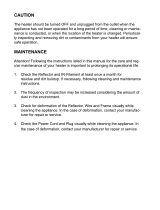
Page 6
operating parameters exists, the gas control diagnostic LED will flash a code to positively
identify an operational issue.
This service manual is designed to facilitate problem diagnosis and enhance service efficiency.
To further promote quicker service times the new gas valve can be removed and replaced
without draining the water heater. A special tool is required and will be provided with each gas
valve kit shipped from our Service Parts department.
Please read the service manual completely before attempting service on this new series of
power
How the Safety System Works
During normal operation, most air for combustion is drawn into the water heater through the
openings in the jacket door. This air travels into the burner venturi, mixing with the gas jet.
This air is then mixed with gas inside the burner and drawn to the burner screen and is
efficiently combusted producing Ultra Low NOx emissions. Additional air is drawn through
the openings in the jacket. This air travels down and around the combustion chamber and
enters through holes in the bottom of the corrosion-resistant combustion chamber. The air then
travels up through the oriented flame arrestor plate louvers, where the velocity of the air is
increased and its direction altered. The air then mixes in a normal manner with the combustion
products from the burner.
In the case where trace amounts of flammable vapors are present in the air flowing into the
combustion chamber and burner venturi, the vapors are harmlessly ignited by the burner / pilot
flame. If flammable vapors are in sufficient quantity to prevent normal combustion, the burner
and pilot flames are designed to shut down.
Should the flammable vapors continue to the burner, the flame arrestor plate and burner screen
prevent the flames from traveling backwards and igniting vapors outside of the combustion
chamber. This causes the thermopile to overheat and shuts down the main pilot and burner. The
thermopile powers the intelligent diagnostic control which is capable of recognizing restricted
airflow conditions caused by severe lint, dust and oil accumulation on the burner screen and
arrestor plate. The intelligent diagnostic control will deactivate the burner and pilot in the
unlikely event of restricted airflow.
How to Use this Manual
It is intended for this manual to be used by qualified service personnel for the primary purpose
of troubleshooting and repair of the Bradford White Residential Flue Damper water heaters.
Understanding the sequence of operation section of this manual will contribute greatly to
troubleshooting the water heater.
The Honeywell WV4460E Electronic Gas Control will display error codes in the event of
abnormal operation. Error codes are listed in the troubleshooting chart beginning on page 13 of
this service manual. The troubleshooting chart will also indicate the probable cause for the error
code and direct the service professional to a service procedure to properly diagnose the
abnormal operation.
How to Use this Manual























